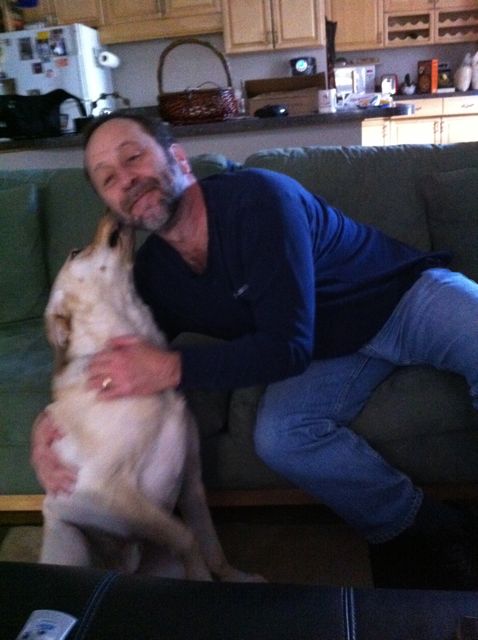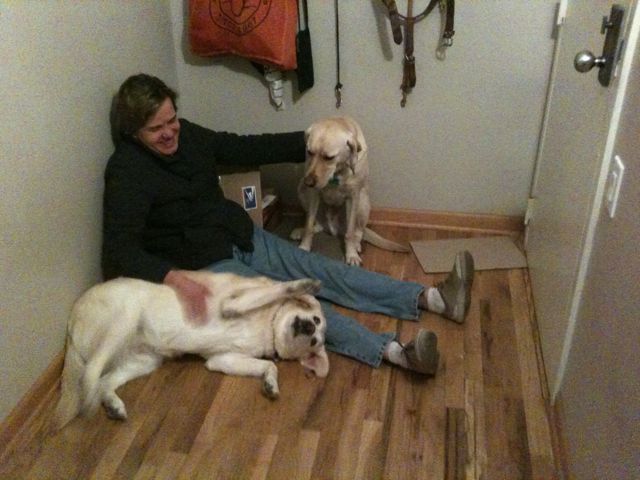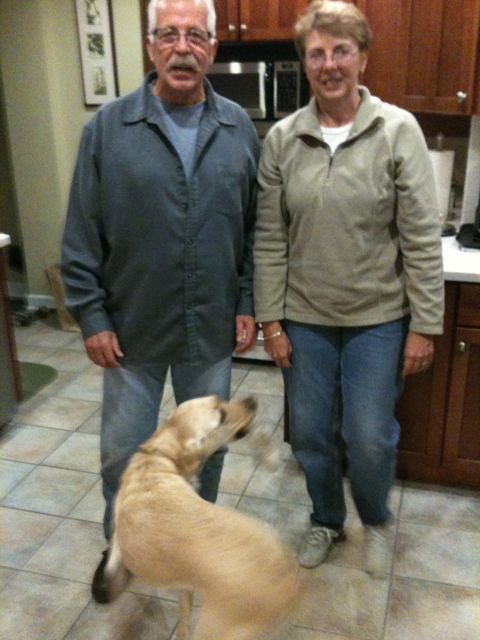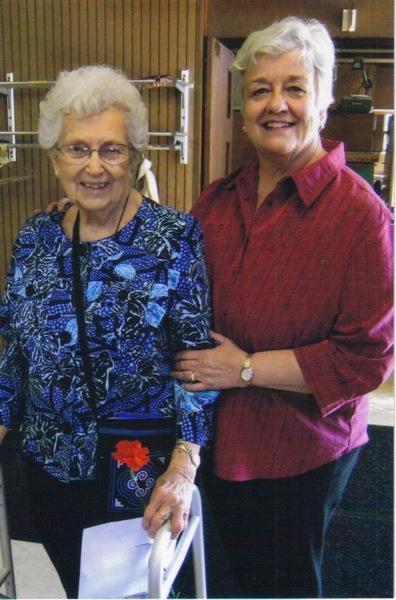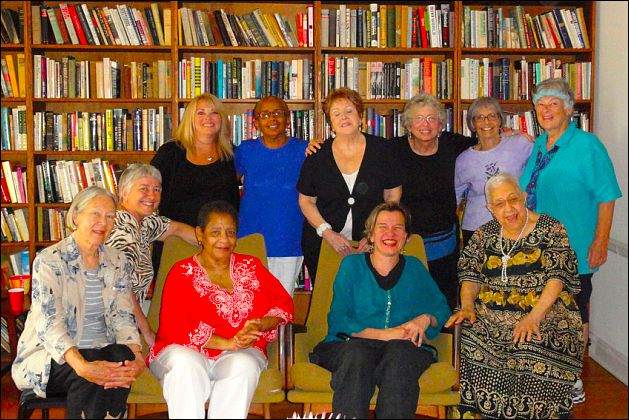Man's best friends
November 7, 2011 • 13 Comments • Posted in Beth Finke, guide dogs, Mike Knezovich, Seeing Eye dogs, UncategorizedHere’s another post from my husband Mike Knezovich. I’ll be back later this week.
Sunday, for the second time in the last 12 months, I carried the dog bed, toys, and other canine accoutrement to the car to drive Beth’s retired Seeing Eye dog to new digs. Last year it was Hanni headed to Urbana and Steven and Nancy’s. This year it was Harper to Wheaton and Chris and Larry’s.
We had one last shindig with Harper the day before. Steven and Nancy—who are Hanni’s current humans—were kind enough to drive up with her for the retirement party. We made one attempt at a walk together—thinking that Harper might forget his invisible force field and follow Hanni down the block to the park. No luck. Harper has his boundaries and that’s that.
Hanni, however, was in full glory. While Steven, Nancy, and I waited for Beth to meet us with Harper, a CTA bus came to a stop for a red light. The driver opened his window, stuck out his head, and said, “That’s a beautiful dog. Is it a Lab?” We shouted back that it was a Lab-Golden mix. “She’s beautiful,” he said, and then the bus roared north on Dearborn.
We had a great time Saturday and so did the dogs. And the Sunday transition was eased a bit this year because I had company for the trip: Beth. The Seeing Eye encouraged us to take the pressure off Harper as soon as we could; Beth’s not headed to New Jersey to get matched with a new dog until later this month.
As difficult as letting Hanni go was—after nine years of her being part of our household—this time has been harder, for me at least. With Hanni, things had run their natural course. She’d had a great career, she was slowing down, it was time.
With Harper, if you follow this blog, you know this is different. For one, there’s just the disappointment that we’re going through this again so soon, and that Beth’s going to be gone for nearly three weeks—working like a dog with a dog—in New Jersey. For another, it’s just sad to see Harper go. Things didn’t go as planned, but somehow, in a relatively short time, I grew more attached to Harper than I did Beth’s other dogs.
First, it’s not an exaggeration to say that he saved Beth’s life. Second, when we and the The Seeing Eye concluded that it really was not going to work with Harper, I was free to treat Harper like he was our dog, not Beth’s service animal.
So I was caught by surprise by how sad I was yesterday. A blithering mess. I mean, it’s a DOG right?
But it’s pretty easy to empathize with Harper. Harper was different right from the start. He’s strong as an ox but gentle as a lamb. He’s composed, deliberate, and almost regal. He even walks around the house quietly. As Beth noted, if you hung out with Hanni and Harper off-harness for a while you’d swear he must be the better guide dog. While Harper will gently take a treat from your fingertips, Hanni will just about take your hand off. And she rolls over on her back for a belly rub at the drop of a hat.
Harper’s serious. He’s a worrier—to an extreme I think, and this I absolutely empathize with.
Apart from that, we asked Harper to do very difficult things—he did them—but it ultimately was beyond his limit. The trauma of the near miss with the car aggregated with the daily stress of downtown Chicago got the better of him.
We humans can certainly understand this. And how it takes its toll—we see it in war veterans as Post Traumatic Stress Disorder. We see it in other folks as crippling anxiety, depression, and other mental disorders. Some of it is probably inevitable—life is a struggle. But it seems like we make it harder for each other than maybe we need to. I don’t know.
What I do know is that Harper now lives on a quiet, leafy street in the suburbs, in a lovely brick home decorated in arts & crafts style, with a beautifully tended, fenced back yard. He shares this home with a cat named George and two humans named Chris and Larry.
We met Chris and Larry through our mutual friend Greg (that’s a story in itself for another day). We don’t have a long history with Chris and Larry—when Greg comes to town, we all get together and very much enjoy our time. That’s been about once a year for the last few. The last time was at our place, and that’s when Chris and Larry met Harper.
When it became clear that bringing Harper to France with us in September was just not going to work (he won’t walk a block south from our apartment, so France seemed like a bridge too far), it was Chris and Larry to the rescue. They came and picked up our boy and had a nice time with him.
They also witnessed his behavior—he would not walk more than a block or so from their house before turning around and high-tailing it for home. But they enjoyed Harper, and he enjoyed hanging out in their back yard, discovering squirrels and life outside the city.
Beth and I both thought they’d be great for Harper because it would get him out of the city chaos. Plus, they’d witnessed his behavior, which you sort of have to see to really believe. They’d know what they were taking on.
When Beth asked them whether they’d be interested in adopting him, they asked to think about it for a day. And then said yes.
When we arrived Sunday Harper bolted the car and ran up to Larry and Chris and then headed for the front door. Inside he seemed completely at home.
So did we. Over a bowl of chili we learned a lot about our new friends. Larry joined the army after high school and went to Viet Nam. He eventually re-enlisted in the reserves. That’s where he and Chris met—she’d joined the reserves to help pay for college. Mostly, we learned these are people who have lived full, sometimes challenging lives, and they have a depth of understanding and kindness that makes you feel good when you’re around it.
As our visit wound down, and I woofed a really good piece of pumpkin cheesecake Chris had made, I speculated that Harper, after some time just being a dog, would go on normal walks again. Everyone seconded that hope.
Larry added, “And if he doesn’t, this guy never has to leave the back yard if he doesn’t want to.”
We certainly can make life unnecessarily hard for ourselves and others. But Chris and Larry reminded me of how caring folks can be, how they can ease our way, and how remarkably lucky Beth and I are to have the friends we do. Thank you all.
